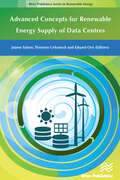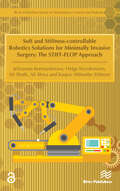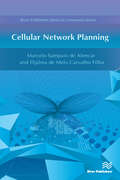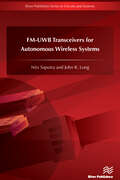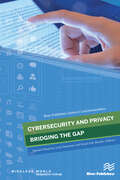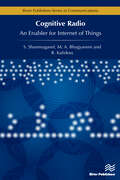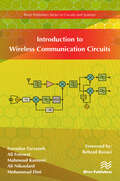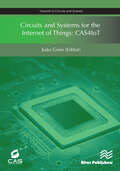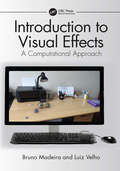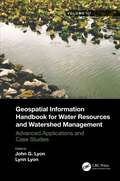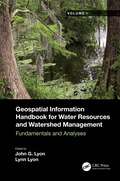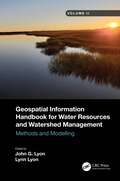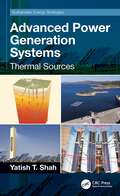- Table View
- List View
Advanced Concepts for Renewable Energy Supply of Data Centres (River Publishers Series In Renewable Energy Ser.)
by Jaume Salom Thorsten Urbaneck Eduard OróThe rapid increase of cloud computing, high performance computing (HPC) and the vast growth in Internet and Social Media use have aroused the interest in energy consumption and the carbon footprint of Data Centres. Data Centres primarily contain electronic equipment used for data processing (servers), data storage (storage equipment), and communications (network equipment). Collectively, this equipment processes, stores, and transmits digital information and is known as information technology (IT) equipment. Advanced Concepts for Renewable Energy Supply of Data Centres introduces a number of technical solutions for the supply of power and cooling energy into Data Centres with enhanced utilisation of renewable energy sources in order to achieve low energy Data Centres. Because of the high energy density nature of these unique infrastructures, it is essential to implement energy efficiency measures and reduce consumption before introducing any renewable energy source. A holistic approach is used with the objective of integrating many technical solutions such as management of the IT (Information Technology) load, efficient electrical supply to the IT systems, Low-Ex air-conditioning systems, interaction with district heating and cooling networks, re-use of heat, free cooling (air, seawater, groundwater), optimal use of heat and cold storage, electrical storage and integration in smart grids. This book is therefore a catalogue of advanced technical concepts that could be integrated into Data Centres portfolio in order to increase the overall efficiency and the share of renewable energies in power and cooling supply. Based on dynamic energy models implemented in TRNSYS some concepts are deeply evaluated through yearly simulations. The results of the simulation are illustrated with Sankey charts, where the energy flows per year within the subsystems of each concept for a selected scenario are shown, and graphs showing the results of parametric analysis. A set of environmental metrics (as the non-renewable primary energy) and financial metrics (CAPEX and OPEX) as well of energy efficiency metrics like the well-known PUE, are described and used to evaluate the different technical concepts.
Soft and Stiffness-controllable Robotics Solutions for Minimally Invasive Surgery: The STIFF-FLOP Approach
by Jelizaveta Konstantinova Helge Wurdemann Ali Shafti Ali Shiva Kaspar AlthoeferSoft and Stiffness-controllable Robotics Solutions for Minimally Invasive Surgery presents the results of a research project, funded by European Commission, STIFF-FLOP: STIFFness controllable Flexible and Learn-able manipulator for surgical Operations. In Minimally Invasive Surgery (MIS), tools go through narrow openings and manipulate soft organs that can move, deform, or change stiffness. There are limitations on modern laparoscopic and robot-assisted surgical systems due to restricted access through Trocar ports, lack of haptic feedback, and difficulties with rigid robot tools operating inside a confined space filled with organs. Also, many control algorithms suffer from stability problems in the presence of unexpected conditions. Yet biological "manipulators", like the octopus arm can manipulate objects while controlling the stiffness of selected body parts and being inherently compliant when interacting with objects. STIFF-FLOP robot is an innovative soft robotic arm that can squeeze through a standard MIS, reconfigure itself and stiffen by hydrostatic actuation to perform compliant force control tasks while facing unexpected situations. Technical topics discussed in the book include:Soft actuatorsContinuum soft manipulatorsControl, kinematics and navigation of continuum manipulatorsOptical sensors for force, torque, and curvatureHaptic feedback and human interface for surgical systemsValidation of soft stiffness controllable robots
Cellular Network Planning
by Marcelo Sampaio Alencar Djalma de Melo Carvalho FilhoOver the recent years, few books have been published covering all the subjects needed to understand the very fundamental concepts of cell planning. Most books which deal with this topic are destined to very specific audiences, and the vast majority introduce the subject at a very basic, or technical, level, or are destined to an academic audience. Cellular Network Planning begins with an introduction to the subject, covering conventional and contemporary wireless systems. Spectral allocation and the frequency plan are discussed, along with the essential characteristics of wireless systems. The design of mobile cellular systems includes cell planning, traffic and channel problems. The book presents a review of existing models, considering both green field dimensioning and network expansion strategies, and discusses multi-objective optimization and base station deployment based on artificial immune systems. It also discusses a cost-effective base station deployment approach based on artificial immune systems, and introduces the modified MO-AIS algorithm.
FM-UWB Transceivers for Autonomous Wireless Systems (River Publishers Series In Circuits And Systems Ser.)
by Nitz Saputra John R. LongSignificant research effort has been devoted to the study and realization of autonomous wireless systems for wireless sensor and personal-area networking, the internet of things, and machine-to-machine communications. Low-power RF integrated circuits, an energy harvester and a power management circuit are fundamental elements of these systems. An FM-UWB Transceiver for Autonomous Wireless Systems presents state-of-the-art developments in low-power FM-UWB transceiver realizations. The design, performance and implementation of prototype transceivers in CMOS technology are presented. A working hardware realization of an autonomous node that includes a prototype power management circuit is also proposed and detailed in this book.Technical topics include: Low-complexity FM-UWB modulation schemesLow-power FM-UWB transceiver prototypes in CMOS technologyCMOS on-chip digital calibration techniquesSolar power harvester and power management in CMOS for low-power RF circuitsAn FM-UWB Transceiver for Autonomous Wireless Systems is an ideal text and reference for engineers working in wireless communication industries, as well as academic staff and graduate students engaged in electrical engineering and communication systems research.
Cybersecurity and Privacy - Bridging the Gap
by Samant Khajuria Lene Tolstrup Sørensen Knud Erik SkoubyThe huge potential in future connected services has as a precondition that privacy and security needs are dealt with in order for new services to be accepted. This issue is increasingly on the agenda both at company and at individual level. Cybersecurity and Privacy - bridging the gap addresses two very complex fields of the digital world, i.e., Cybersecurity and Privacy. These multifaceted, multidisciplinary and complex issues are usually understood and valued differently by different individuals, data holders and legal bodies. But a change in one field immediately affects the others. Policies, frameworks, strategies, laws, tools, techniques, and technologies - all of these are tightly interwoven when it comes to security and privacy. This book is another attempt to bridge the gap between the industry and academia. The book addresses the views from academia and industry on the subject.
Cognitive Radio - An Enabler for Internet of Things
by R. Kalidoss M. A. Bhagyaveni K. S. VishvaksenanInternet of Things (IoT) deals with the interconnection of devices that can communicate with each other over the internet. Currently, several smart systems have evolved with the evolution in IoT. Cognitive Radio - an enabler for Internet of Things is a research level subject for all communication engineering students at undergraduate, post graduate and research levels. The contents of the book are designed to cover the prescribed syllabus for one semester course on the subject prescribed by universities. Concepts have been explained thoroughly in simple and lucid language. Mathematical analysis has been used wherever necessary followed by clear and lucid explanation of the findings and their implication. Key technologies presented include dynamic spectrum access, spectrum sensing techniques, IEEE 802.22 and different radio network architectures. Their role and use in the context of mobile broadband access in general is explained, giving both a high level overview and a detailed step by step explanation. The book includes a large number of diagrams, MATLAB examples, thereby enabling the readers to have a sound grasp of the concepts presented and their applications. This book is a must have resource for engineers and other professionals in the telecommunication industry working with cellular or wireless broadband technologies, helping comprehension of the process of utilization of the updated technology to enable being ahead competition.
Introduction to Wireless Communication Circuits (River Publishers Series In Circuits And Systems Ser.)
by Forouhar Farzaneh Ali Fotowat Mahmoud KamareiOver the past decade, tremendous development of Wireless Communications has changed human life and engineering. Considerable advancement has been made in design and architecture of related RF and microwave circuits. Introduction to Wireless Communication Circuits focusses on special circuits dedicated to the RF level of wireless communications. From oscillators to modulation and demodulation, and from mixers to RF and power amplifier circuits, all are presented in a sequential manner. A wealth of analytical relations is provided in the text alongside various worked out examples. Related problem sets are given at the end of each chapter. Basic concepts of RF Analog Circuit Design are developed in the book.
Circuits and Systems for the Internet of Things: CAS4IoT
by João GoesInternet-of-Things (IoT) can be envisaged as a dynamic network of interconnected physical and virtual entities (things), with their own identities and attributes, seamlessly integrated in order to e.g. actively participate in economic or societal processes, interact with services, and react autonomously to events while sensing the environment. By enabling things to connect and becoming recognizable, while providing them with intelligence, informed and context based decisions are expected in a broad range of domains spanning from health and elderly care to energy efficiency, either providing business competitive advantages to companies, either addressing key social concerns. The level of connectivity and analytical intelligence provided by the IoT paradigm is expected to allow creating new services that would not be feasible by other means. This CAS4IoT book targets post-graduate students and design engineers, with the skills to understand and design a broader range of analog, digital and mixed-signal circuits and systems, in the field of IoT, spanning from data converters for sensor interfaces to radios, ensuring a good balance between academia and industry, combined with a judicious selection of worldwide distinguished authors.
Advanced Concepts for Renewable Energy Supply of Data Centres
The rapid increase of cloud computing, high performance computing (HPC) and the vast growth in Internet and Social Media use have aroused the interest in energy consumption and the carbon footprint of Data Centres. Data Centres primarily contain electronic equipment used for data processing (servers), data storage (storage equipment), and communications (network equipment). Collectively, this equipment processes, stores, and transmits digital information and is known as information technology (IT) equipment. Advanced Concepts for Renewable Energy Supply of Data Centres introduces a number of technical solutions for the supply of power and cooling energy into Data Centres with enhanced utilisation of renewable energy sources in order to achieve low energy Data Centres. Because of the high energy density nature of these unique infrastructures, it is essential to implement energy efficiency measures and reduce consumption before introducing any renewable energy source. A holistic approach is used with the objective of integrating many technical solutions such as management of the IT (Information Technology) load, efficient electrical supply to the IT systems, Low-Ex air-conditioning systems, interaction with district heating and cooling networks, re-use of heat, free cooling (air, seawater, groundwater), optimal use of heat and cold storage, electrical storage and integration in smart grids. This book is therefore a catalogue of advanced technical concepts that could be integrated into Data Centres portfolio in order to increase the overall efficiency and the share of renewable energies in power and cooling supply. Based on dynamic energy models implemented in TRNSYS some concepts are deeply evaluated through yearly simulations. The results of the simulation are illustrated with Sankey charts, where the energy flows per year within the subsystems of each concept for a selected scenario are shown, and graphs showing the results of parametric analysis. A set of environmental metrics (as the non-renewable primary energy) and financial metrics (CAPEX and OPEX) as well of energy efficiency metrics like the well-known PUE, are described and used to evaluate the different technical concepts.
Soft and Stiffness-controllable Robotics Solutions for Minimally Invasive Surgery: The STIFF-FLOP Approach
Soft and Stiffness-controllable Robotics Solutions for Minimally Invasive Surgery presents the results of a research project, funded by European Commission, STIFF-FLOP: STIFFness controllable Flexible and Learn-able manipulator for surgical Operations. In Minimally Invasive Surgery (MIS), tools go through narrow openings and manipulate soft organs that can move, deform, or change stiffness. There are limitations on modern laparoscopic and robot-assisted surgical systems due to restricted access through Trocar ports, lack of haptic feedback, and difficulties with rigid robot tools operating inside a confined space filled with organs. Also, many control algorithms suffer from stability problems in the presence of unexpected conditions. Yet biological "manipulators", like the octopus arm can manipulate objects while controlling the stiffness of selected body parts and being inherently compliant when interacting with objects. STIFF-FLOP robot is an innovative soft robotic arm that can squeeze through a standard MIS, reconfigure itself and stiffen by hydrostatic actuation to perform compliant force control tasks while facing unexpected situations. Technical topics discussed in the book include:Soft actuatorsContinuum soft manipulatorsControl, kinematics and navigation of continuum manipulatorsOptical sensors for force, torque, and curvatureHaptic feedback and human interface for surgical systemsValidation of soft stiffness controllable robots
Cellular Network Planning
by Marcelo Sampaio Alencar Djalma de Melo Carvalho FilhoOver the recent years, few books have been published covering all the subjects needed to understand the very fundamental concepts of cell planning. Most books which deal with this topic are destined to very specific audiences, and the vast majority introduce the subject at a very basic, or technical, level, or are destined to an academic audience. Cellular Network Planning begins with an introduction to the subject, covering conventional and contemporary wireless systems. Spectral allocation and the frequency plan are discussed, along with the essential characteristics of wireless systems. The design of mobile cellular systems includes cell planning, traffic and channel problems. The book presents a review of existing models, considering both green field dimensioning and network expansion strategies, and discusses multi-objective optimization and base station deployment based on artificial immune systems. It also discusses a cost-effective base station deployment approach based on artificial immune systems, and introduces the modified MO-AIS algorithm.
FM-UWB Transceivers for Autonomous Wireless Systems
by Nitz Saputra John R. LongSignificant research effort has been devoted to the study and realization of autonomous wireless systems for wireless sensor and personal-area networking, the internet of things, and machine-to-machine communications. Low-power RF integrated circuits, an energy harvester and a power management circuit are fundamental elements of these systems. An FM-UWB Transceiver for Autonomous Wireless Systems presents state-of-the-art developments in low-power FM-UWB transceiver realizations. The design, performance and implementation of prototype transceivers in CMOS technology are presented. A working hardware realization of an autonomous node that includes a prototype power management circuit is also proposed and detailed in this book.Technical topics include: Low-complexity FM-UWB modulation schemesLow-power FM-UWB transceiver prototypes in CMOS technologyCMOS on-chip digital calibration techniquesSolar power harvester and power management in CMOS for low-power RF circuitsAn FM-UWB Transceiver for Autonomous Wireless Systems is an ideal text and reference for engineers working in wireless communication industries, as well as academic staff and graduate students engaged in electrical engineering and communication systems research.
Cybersecurity and Privacy - Bridging the Gap
The huge potential in future connected services has as a precondition that privacy and security needs are dealt with in order for new services to be accepted. This issue is increasingly on the agenda both at company and at individual level. Cybersecurity and Privacy - bridging the gap addresses two very complex fields of the digital world, i.e., Cybersecurity and Privacy. These multifaceted, multidisciplinary and complex issues are usually understood and valued differently by different individuals, data holders and legal bodies. But a change in one field immediately affects the others. Policies, frameworks, strategies, laws, tools, techniques, and technologies - all of these are tightly interwoven when it comes to security and privacy. This book is another attempt to bridge the gap between the industry and academia. The book addresses the views from academia and industry on the subject.
Cognitive Radio - An Enabler for Internet of Things
by R. Kalidoss M. A. Bhagyaveni K. S. VishvaksenanInternet of Things (IoT) deals with the interconnection of devices that can communicate with each other over the internet. Currently, several smart systems have evolved with the evolution in IoT. Cognitive Radio - an enabler for Internet of Things is a research level subject for all communication engineering students at undergraduate, post graduate and research levels. The contents of the book are designed to cover the prescribed syllabus for one semester course on the subject prescribed by universities. Concepts have been explained thoroughly in simple and lucid language. Mathematical analysis has been used wherever necessary followed by clear and lucid explanation of the findings and their implication. Key technologies presented include dynamic spectrum access, spectrum sensing techniques, IEEE 802.22 and different radio network architectures. Their role and use in the context of mobile broadband access in general is explained, giving both a high level overview and a detailed step by step explanation. The book includes a large number of diagrams, MATLAB examples, thereby enabling the readers to have a sound grasp of the concepts presented and their applications. This book is a must have resource for engineers and other professionals in the telecommunication industry working with cellular or wireless broadband technologies, helping comprehension of the process of utilization of the updated technology to enable being ahead competition.
Introduction to Wireless Communication Circuits
by Forouhar Farzaneh Ali Fotowat Mahmoud KamareiOver the past decade, tremendous development of Wireless Communications has changed human life and engineering. Considerable advancement has been made in design and architecture of related RF and microwave circuits. Introduction to Wireless Communication Circuits focusses on special circuits dedicated to the RF level of wireless communications. From oscillators to modulation and demodulation, and from mixers to RF and power amplifier circuits, all are presented in a sequential manner. A wealth of analytical relations is provided in the text alongside various worked out examples. Related problem sets are given at the end of each chapter. Basic concepts of RF Analog Circuit Design are developed in the book.
Circuits and Systems for the Internet of Things: CAS4IoT
Internet-of-Things (IoT) can be envisaged as a dynamic network of interconnected physical and virtual entities (things), with their own identities and attributes, seamlessly integrated in order to e.g. actively participate in economic or societal processes, interact with services, and react autonomously to events while sensing the environment. By enabling things to connect and becoming recognizable, while providing them with intelligence, informed and context based decisions are expected in a broad range of domains spanning from health and elderly care to energy efficiency, either providing business competitive advantages to companies, either addressing key social concerns. The level of connectivity and analytical intelligence provided by the IoT paradigm is expected to allow creating new services that would not be feasible by other means. This CAS4IoT book targets post-graduate students and design engineers, with the skills to understand and design a broader range of analog, digital and mixed-signal circuits and systems, in the field of IoT, spanning from data converters for sensor interfaces to radios, ensuring a good balance between academia and industry, combined with a judicious selection of worldwide distinguished authors.
Introduction to Visual Effects: A Computational Approach
by Bruno Madeira Luiz VelhoIntroduction to Visual Effects: A Computational Approach is the first single introduction to the computational and mathematical aspects of visual effects, incorporating both computer vision and graphics. The book also provides the readers with the source code to a library, enabling them to follow the chapters directly and build up a complete visual effects platform. The book covers the basic approaches to camera pose estimation, global illumination, and image-based lighting, and includes chapters on the virtual camera, optimization and computer vision, path tracing and many more. Key features include: Introduction to projective geometry, image-based lighting (IBL), global illumination solved by the Monte Carlo method (Pathtracing), an explanation of a set of optimization methods, and the techniques used for calibrating one, two, and many cameras, including how to use the RANSAC algorithm in order to make the process robust, and providing code to be implemented using the Gnu Scientific Library. C/C++ code using the OpenCV library, to be used in the process of tracking points on a movie (an important step for the matchmove process), and in the construction of modeling tools for visual effects. A simple model of the Bidirectional Reflectance Distribution Function (BRDF) of surfaces and the differential rendering method, allowing the reader to generate consistent shadows, supported by a code that can be used in combination with a software like Luminance HDR.
Introduction to Visual Effects: A Computational Approach
by Bruno Madeira Luiz VelhoIntroduction to Visual Effects: A Computational Approach is the first single introduction to the computational and mathematical aspects of visual effects, incorporating both computer vision and graphics. The book also provides the readers with the source code to a library, enabling them to follow the chapters directly and build up a complete visual effects platform. The book covers the basic approaches to camera pose estimation, global illumination, and image-based lighting, and includes chapters on the virtual camera, optimization and computer vision, path tracing and many more. Key features include: Introduction to projective geometry, image-based lighting (IBL), global illumination solved by the Monte Carlo method (Pathtracing), an explanation of a set of optimization methods, and the techniques used for calibrating one, two, and many cameras, including how to use the RANSAC algorithm in order to make the process robust, and providing code to be implemented using the Gnu Scientific Library. C/C++ code using the OpenCV library, to be used in the process of tracking points on a movie (an important step for the matchmove process), and in the construction of modeling tools for visual effects. A simple model of the Bidirectional Reflectance Distribution Function (BRDF) of surfaces and the differential rendering method, allowing the reader to generate consistent shadows, supported by a code that can be used in combination with a software like Luminance HDR.
Geospatial Information Handbook for Water Resources and Watershed Management, Volume III: Advanced Applications and Case Studies
by G. Lyon JohnVolume III of Geospatial Information Handbook for Water Resources and Watershed Management discusses water and watershed issues such as water quality, evapotranspiration, water resource management, and ecological services. Featured is a two-stage ditch and river geomorphology case study section with related water geospatial applications, including historical image analyses of floodplains and channels and resulting change in river geomorphology through erosion and transport and influence on dependent vegetation communities. Captures advanced Geospatial Technologies (GT) and their applications to address a wide spectrum of water issues Provides real-world two-stage ditch and river geomorphology case studies using river, stream and channel measures and change models, and bankfull discharge modeling Global in coverage with applications demonstrated by more than 170 experts in water sciences and two-stage ditch and river geomorphology This handbook is a wide-ranging and contemporary reference of advanced geospatial techniques used in numerous practical applications at the local and regional scale and is an in-depth resource for professionals and the water research community worldwide.
Geospatial Information Handbook for Water Resources and Watershed Management, Volume I: Fundamentals and Analyses
by Lyon John G.Volume I of Geospatial Information Handbook for Water Resources and Watershed Management discusses fundamental characteristics, measurements, and analyses of water features and watersheds including lakes and reservoirs, rivers and streams, and coasts and estuaries. It presents contemporary knowledge on Geospatial Technology (GT)–supported functional analyses of water runoff, storage and balance, flooding and floodplains, water quality, soils and moisture, climate vulnerabilities, and ecosystem services. Captures advanced Geospatial Technologies (GTs) addressing a wide range of water issues Provides real-world applications and case studies using advanced spectral and spatial sensors combined with geospatially facilitated water process models Details applications of ArcInfo/ArcGIS, Google Earth Engine, and other systems using advanced remote sensors, including hyperspectral ER2 AVIRIS, Sentinel-1 and -2, MODIS, Landsat 7 ETM+, Landsat 8 OLI and TIPS, SAR radar, and thermal imaging Global in coverage with applications contributed by more than 170 authors with lifelong expertise in water sciences and engineering This handbook is a wide-ranging and contemporary reference of advanced geospatial techniques used in numerous practical applications at the local and regional scales and is an in-depth resource for professionals and the water research community worldwide.
Geospatial Information Handbook for Water Resources and Watershed Management, Volume II: Methods and Modelling
by G. Lyon JohnVolume II of Geospatial Information Handbook for Water Resources and Watershed Management discusses Geospatial Technology (GT) approaches using integrated modeling as applied to advanced water resource assessments. Features include multiple date land cover analyses as change in land cover influences water quality, model sensitivity analyses of DEM resolution and influences on modeling water characteristics like Manning’s n, development of seabed cover classification and sensitivity, and forecasting urban growth over time with climate vulnerability impacts on water. A detailed case study presents a range of water quality issues, all effectively demonstrating GT inputs to water quality studies from headwaters to receiving estuarine waters. Also analyzed are the comparison of evapotranspiration simulation performance by APEX model in dryland and irrigated cropping systems and perspectives on the future of transient storage modeling. Captures advanced technologies and applications for implementation with models to address a broad spectrum of water issues Provides real-world applications and case studies using advanced spectral and spatial sensors combined with geospatially facilitated water process models Features a Neuse River Basin case study integrating hydrologic methods and modeling along with remote sensing and GIS technologies for nonpoint source water quality evaluations Global coverage with applications demonstrated by more than 170 experts from around the world This handbook is a wide-ranging and contemporary reference of advanced geospatial techniques used in numerous practical applications at the local and regional scale and is an in-depth resource for professionals and the water research community worldwide.
Geospatial Information Handbook for Water Resources and Watershed Management, Volume III: Advanced Applications and Case Studies
by John G. Lyon Lynn LyonVolume III of Geospatial Information Handbook for Water Resources and Watershed Management discusses water and watershed issues such as water quality, evapotranspiration, water resource management, and ecological services. Featured is a two-stage ditch and river geomorphology case study section with related water geospatial applications, including historical image analyses of floodplains and channels and resulting change in river geomorphology through erosion and transport and influence on dependent vegetation communities. Captures advanced Geospatial Technologies (GT) and their applications to address a wide spectrum of water issues Provides real-world two-stage ditch and river geomorphology case studies using river, stream and channel measures and change models, and bankfull discharge modeling Global in coverage with applications demonstrated by more than 170 experts in water sciences and two-stage ditch and river geomorphology This handbook is a wide-ranging and contemporary reference of advanced geospatial techniques used in numerous practical applications at the local and regional scale and is an in-depth resource for professionals and the water research community worldwide.
Geospatial Information Handbook for Water Resources and Watershed Management, Volume I: Fundamentals and Analyses
by John G. Lyon Lynn LyonVolume I of Geospatial Information Handbook for Water Resources and Watershed Management discusses fundamental characteristics, measurements, and analyses of water features and watersheds including lakes and reservoirs, rivers and streams, and coasts and estuaries. It presents contemporary knowledge on Geospatial Technology (GT)–supported functional analyses of water runoff, storage and balance, flooding and floodplains, water quality, soils and moisture, climate vulnerabilities, and ecosystem services. Captures advanced Geospatial Technologies (GTs) addressing a wide range of water issues Provides real-world applications and case studies using advanced spectral and spatial sensors combined with geospatially facilitated water process models Details applications of ArcInfo/ArcGIS, Google Earth Engine, and other systems using advanced remote sensors, including hyperspectral ER2 AVIRIS, Sentinel-1 and -2, MODIS, Landsat 7 ETM+, Landsat 8 OLI and TIPS, SAR radar, and thermal imaging Global in coverage with applications contributed by more than 170 authors with lifelong expertise in water sciences and engineering This handbook is a wide-ranging and contemporary reference of advanced geospatial techniques used in numerous practical applications at the local and regional scales and is an in-depth resource for professionals and the water research community worldwide.
Geospatial Information Handbook for Water Resources and Watershed Management, Volume II: Methods and Modelling
by John G. Lyon Lynn LyonVolume II of Geospatial Information Handbook for Water Resources and Watershed Management discusses Geospatial Technology (GT) approaches using integrated modeling as applied to advanced water resource assessments. Features include multiple date land cover analyses as change in land cover influences water quality, model sensitivity analyses of DEM resolution and influences on modeling water characteristics like Manning’s n, development of seabed cover classification and sensitivity, and forecasting urban growth over time with climate vulnerability impacts on water. A detailed case study presents a range of water quality issues, all effectively demonstrating GT inputs to water quality studies from headwaters to receiving estuarine waters. Also analyzed are the comparison of evapotranspiration simulation performance by APEX model in dryland and irrigated cropping systems and perspectives on the future of transient storage modeling. Captures advanced technologies and applications for implementation with models to address a broad spectrum of water issues Provides real-world applications and case studies using advanced spectral and spatial sensors combined with geospatially facilitated water process models Features a Neuse River Basin case study integrating hydrologic methods and modeling along with remote sensing and GIS technologies for nonpoint source water quality evaluations Global coverage with applications demonstrated by more than 170 experts from around the world This handbook is a wide-ranging and contemporary reference of advanced geospatial techniques used in numerous practical applications at the local and regional scale and is an in-depth resource for professionals and the water research community worldwide.
Advanced Power Generation Systems: Thermal Sources (Sustainable Energy Strategies)
by Yatish T. ShahAdvanced Power Generation Systems: Thermal Sources evaluates advances made in heat-to-power technologies for conventional combustion heat and nuclear heat, along with natural sources of geothermal, solar, and waste heat generated from the use of different sources. These advances will render the landscape of power generation significantly different in just a few decades. This book covers the commercial viability of advanced technologies and identifies where more work needs to be done. Since power is the future of energy, these technologies will remain sustainable over a long period of time. Key Features Covers power generation and heat engines Details photovoltaics, thermo-photovoltaics, and thermoelectricity Includes discussion of nuclear and renewable energy as well as waste heat This book will be useful for advanced students, researchers, and professionals interested in power generation and energy industries.
